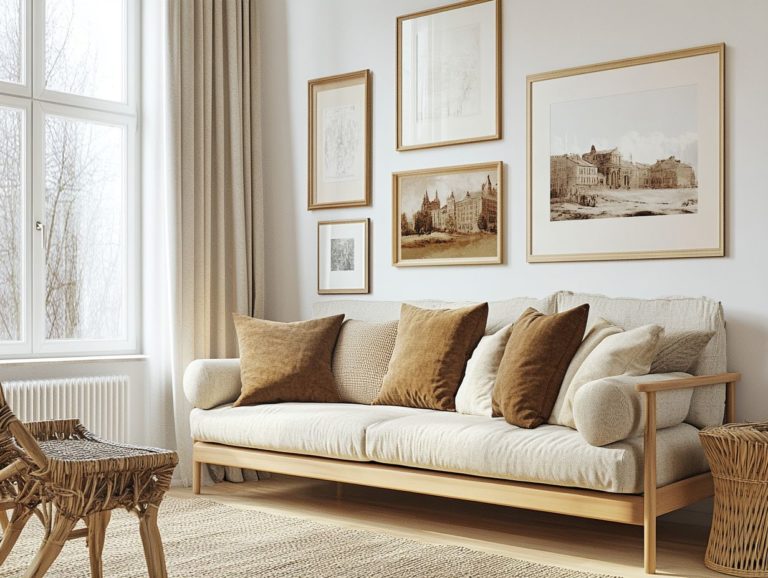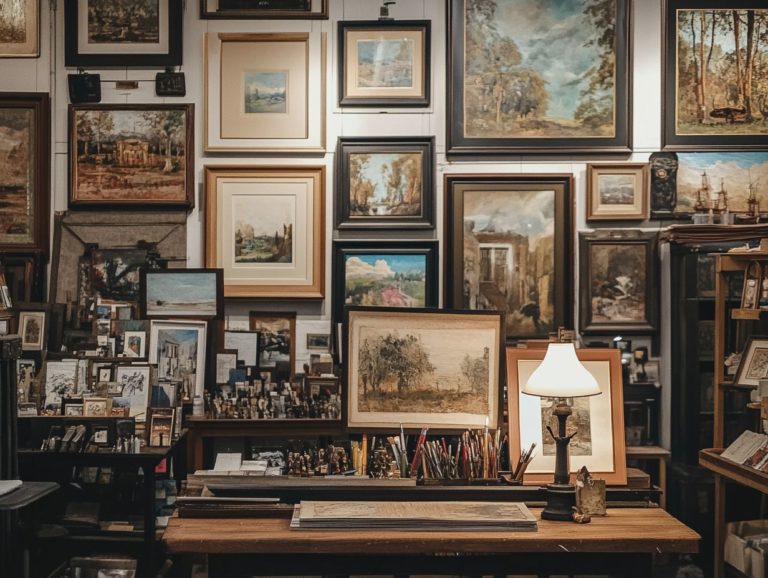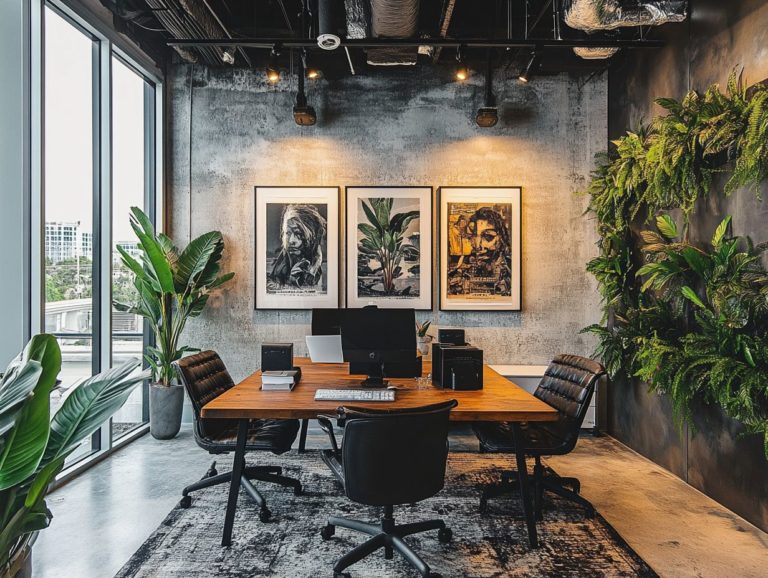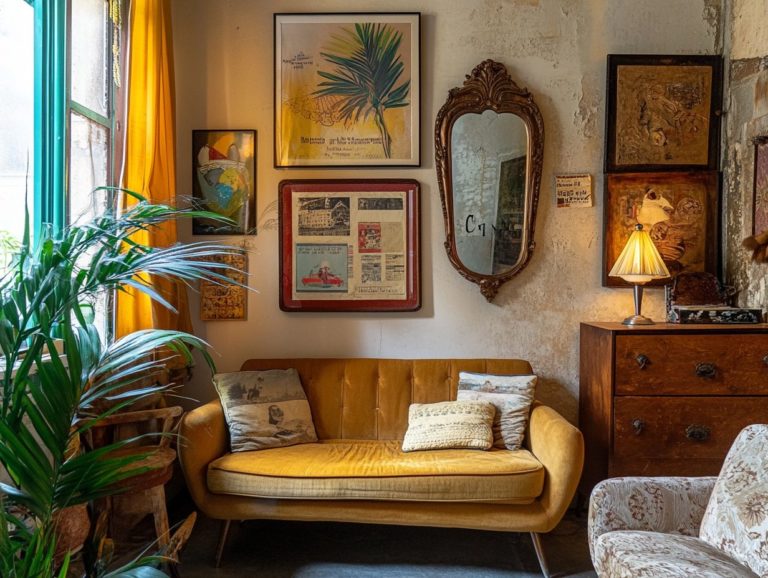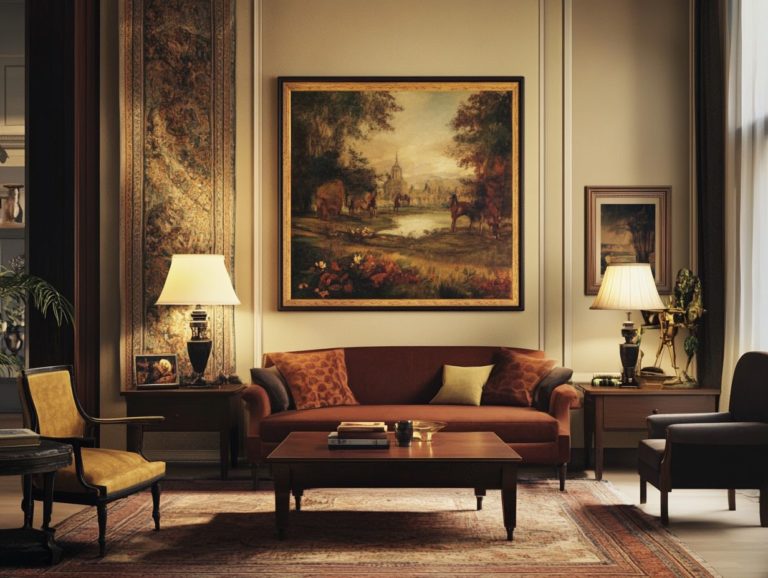Exploring Different Vintage Wall Art Materials
Vintage wall art has the power to transform any space, infusing it with character and a hint of nostalgia.
This exploration delves into the diverse materials that define vintage wall art, including wood, metal, glass, fabric, and paper. It outlines the advantages and disadvantages of each material, providing insight into their durability and maintenance requirements.
You ll also find valuable tips for selecting the right material to complement your style and enhance your space. If the creative spirit moves you, there are DIY techniques included to spark your artistic journey!
Contents
- Key Takeaways:
- Types of Materials Used in Vintage Wall Art
- Metal
- Glass
- Paper
- Fabric
- Pros and Cons of Each Material
- Tips for Choosing the Right Material for Your Space
- DIY Vintage Wall Art: Materials and Techniques
- Frequently Asked Questions
- What are some common materials used in vintage wall art?
- Are there any unique or unconventional materials used in vintage wall art?
- What are the benefits of using wood as a material in vintage wall art?
- How can metal be incorporated into vintage wall art?
- What types of vintage wall art can be made with fabric?
- Do different materials affect the cost of vintage wall art?
Key Takeaways:
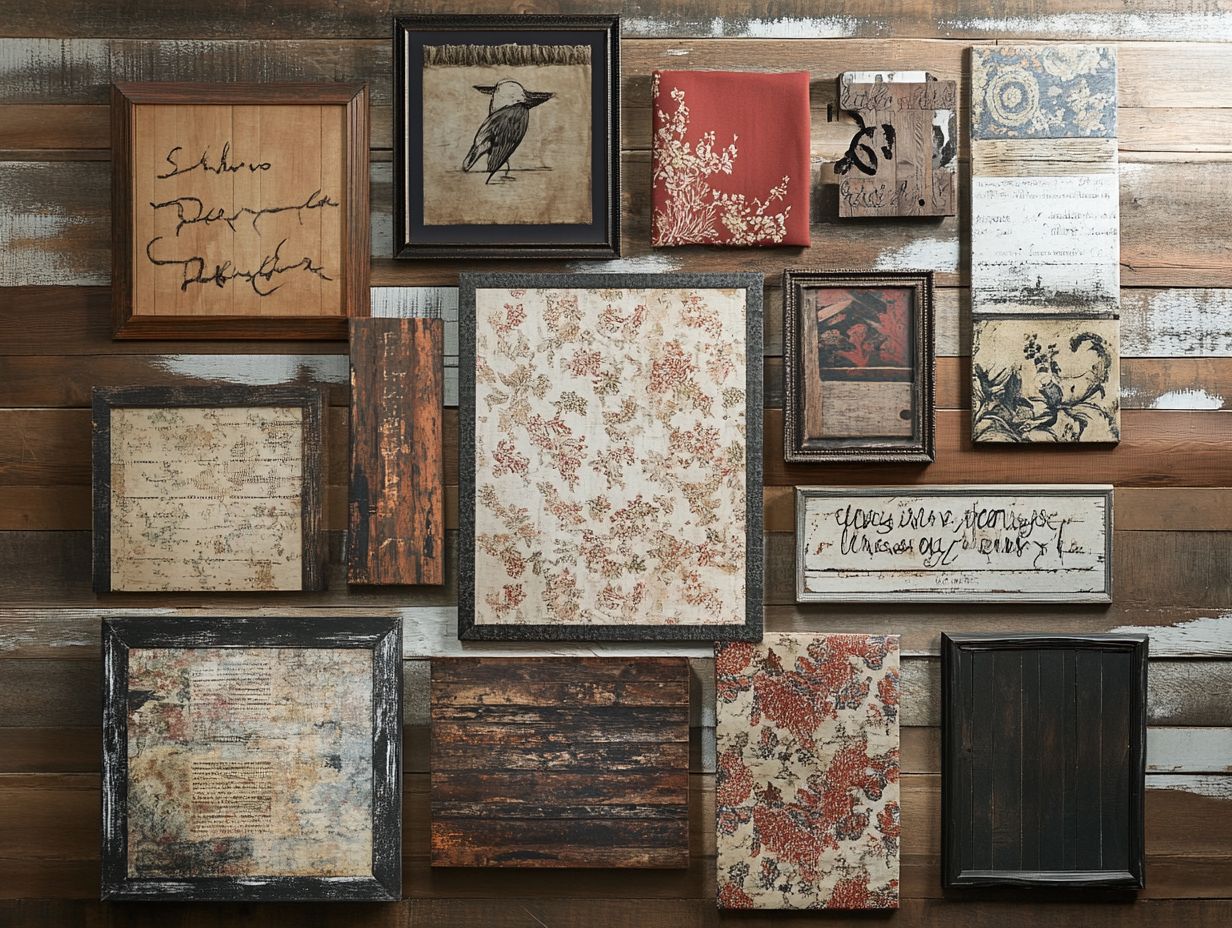
- Explore a world of materials for your vintage wall art!
- Choose materials that reflect your style and meet your needs!
- Get creative and make your own vintage wall art!
Defining Vintage Wall Art
Vintage wall art embodies a captivating fusion of historical value and artistic expression, allowing you to capture the timeless allure of eras long past through an array of vintage decor. These pieces do more than just serve as unique collectibles; they evoke a sense of nostalgia that becomes essential for crafting interiors filled with character and depth.
From intricately framed prints to rustic wooden signs, the styles and materials of vintage art are as diverse as they are enchanting. Often crafted from aged papers, canvas, and reclaimed wood, these pieces transport you back in time, infusing your space with a rich sense of history and charm. For more inspiration, explore vintage wall art: mixing and matching styles.
Each vintage art piece stands as a testament to expert craftsmanship, inviting conversation and enriching your home with stories and memories. As nostalgia weaves through your decor, it creates a warm, inviting atmosphere that fosters connection, making vintage map wall art an invaluable choice for anyone seeking to elevate their interior design.
Types of Materials Used in Vintage Wall Art
The types of materials you choose for vintage wall art are vital in shaping the aesthetic and overall impact of each piece within your space. From the warm hues of wood to the sleek allure of metal, every material carries its own unique charm and character, offering a diverse range of artistic expression.
Vintage wall art comes in a variety of substances, each enhancing the nostalgic atmosphere, be it the delicate nature of paper prints or the textured feel of fabric pieces. Grasping the significance of these materials is essential for anyone seeking to curate a collection of vintage treasures that resonates with timeless charm. For more insights, check out the history of vintage wall art to align seamlessly with their interior design vision.
Wood
Wood is a classic choice often featured in vintage wall art, celebrated for its timeless charm and its ability to evoke warmth and nostalgia in your home. As a sustainable option, wood can range from intricately carved antique furniture to simple wooden frames that beautifully showcase vintage prints. Each piece you choose contributes to the overall aesthetic of your space.
The natural grain of the wood enhances the artwork’s visual impact, allowing it to blend effortlessly with other vintage decor elements. To truly appreciate how these pieces fit into your home, explore the cultural significance of vintage wall art. Consider the variety of wood types at your disposal, such as rich mahogany, resilient oak, and rustic pine, each possessing distinct characteristics to cater to your unique design sensibilities.
Mahogany, with its deep, reddish hue, adds a touch of elegance to a traditional setting, while oak, known for its strength and intricate grain patterns, complements a more modern rustic style. Pine, on the other hand, offers an airy, light feel that aligns perfectly with Scandinavian designs.
Incorporating these woods into your wall art or furniture not only showcases their historical value but also creates inviting spaces brimming with personality, making every corner of your home resonate with a delightful vintage touch.
Metal
Metal is often linked to industrial elements and adds a distinctive character to vintage wall art, marrying durability with aesthetic appeal. In various forms, metal features bold geometric shapes and intricate designs, providing a striking contrast to softer vintage decor.
The reflective surface of metal art pieces brings vibrant colors to life and enhances the overall ambiance of your room. These pieces make exceptional additions to any curated collection of vintage wall decor.
Different types of metal, such as brass, copper, and wrought iron, carry their own historical significance and distinct qualities. Brass is admired for its warm tones, adding a warm, nostalgic feel that beautifully aligns with vintage aesthetics.
Copper develops a natural greenish layer over time, adding character and depth, often harmonizing with modern themes. Wrought iron, celebrated for its robust durability, fits seamlessly within rustic or industrial styles.
Incorporating these metals elevates the visual appeal of your spaces and pays homage to the rich arts and crafts movement, bridging the gap between past and present.
Glass
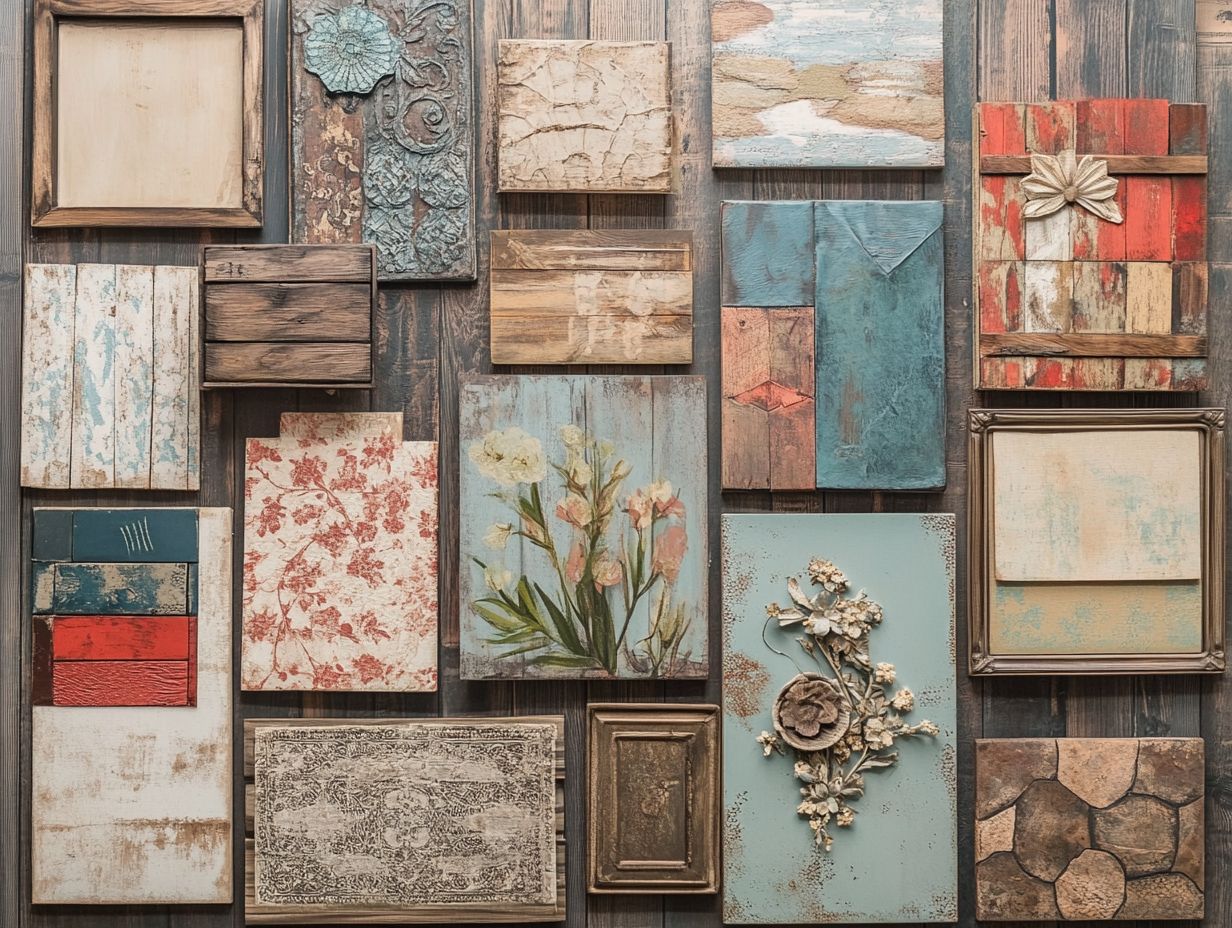
Glass is a versatile material that infuses elegance and sophistication into vintage wall art, transforming ordinary pieces into captivating focal points. Its unique ability to capture and refract light breathes life into glass art, allowing vibrant hues to enrich the nostalgic atmosphere of any room.
Whether you choose stained glass panels or glass-framed vintage posters, this material strikes a delicate balance between transparency and texture. For those interested in pricing, understanding vintage wall art pricing deepens your emotional connection to the art while harmonizing seamlessly with other vintage-inspired accessories.
Incorporating these distinctive vintage items into your interior design can be effortless and rewarding. Stained glass will bring your rustic farmhouse aesthetic to life, creating a cozy ambiance filled with color. Glass prints often complement minimalist or contemporary designs, serving as striking conversation starters without overwhelming your space.
Each type of glass be it frosted, etched, or blown offers timeless charm that evokes nostalgia while embracing modern trends, ultimately enriching the visual narrative of your home.
Paper
Paper serves as a quintessential medium in vintage wall art, encompassing forms like prints, posters, and photographs that evoke a deep emotional connection to the past.
Each type of paper brings its unique character from the smooth gloss of a vintage photograph to the textured allure of handmade paper found in etchings. The quality of the paper is crucial; using high acid-free materials ensures that these nostalgic treasures endure, preventing deterioration.
Using special framing that protects your art from damage elevates the aesthetic charm and safeguards your art from the harmful effects of UV light and humidity. For those looking to infuse their spaces with a distinct flair, choosing vintage artworks on various paper types can significantly enhance the ambiance, inviting stories and memories into contemporary settings.
Fabric
Fabric, often underestimated in the realm of vintage wall art, presents a rich tapestry of texture and color that transforms your interior space. Vintage fabric wall art, whether in the form of tapestries or textile pieces, adds decorative elements that infuse warmth and tactile appeal into your home decor.
The unique patterns and vibrant hues in vintage fabrics contribute to a nostalgic atmosphere, creating an inviting and cohesive look when paired with other vintage-inspired accessories.
You can explore various types of fabric think burlap, linen, and delicate silks to create striking pieces that embody the eclectic essence of vintage aesthetics. Techniques such as appliqué, patchwork, and embroidery intricately weave stories into these artworks, elevating them beyond mere decorative items. For inspiration, check out the best vintage wall art for eclectic spaces.
By incorporating elements like fringe or lace, you can enhance the depth and character of the design. Each piece serves as a visual focal point and connects you to a narrative from the past, evoking memories and emotions that breathe life into any room.
Explore these materials and transform your space today!
Pros and Cons of Each Material
Grasping the advantages and disadvantages of each material in vintage wall art is crucial as you curate your decor. Each material brings its own blend of durability and maintenance needs. This can significantly affect the longevity of your art piece and your commitment to preserving it over time.
Whether you choose the classic allure of wood, the sleek industrial vibe of metal, or the fragile elegance of paper, assessing the unique strengths and weaknesses of each option will profoundly shape your decor choices.
Durability and Maintenance
When selecting vintage wall art, durability and maintenance are key factors to consider. Different materials demand varying levels of care to preserve their beauty and integrity. For example, while metal artwork may stand the test of time, paper prints could benefit from protective framing to prevent fading.
By understanding how each material interacts with environmental elements like light and humidity, you can maintain the value of your unique vintage items for years to come. Regular cleaning keeps your art vibrant! Wooden frames can be gently wiped down with a soft, dry cloth to maintain their natural luster without damaging the finish. Meanwhile, ceramic art pieces might need a gentle wash to keep dust buildup at bay. Additionally, how vintage wall art can add character to your space should not be overlooked.
Also, think about the emotional connection each piece brings into your space; the memories embedded in timeless art deserve to be preserved through careful and mindful maintenance.
By taking these steps, you can ensure that the charm and artistry of your collection remain a significant part of your home s ambiance.
Tips for Choosing the Right Material for Your Space

Selecting the perfect material for your vintage wall art is crucial for creating a harmonious aesthetic while elevating the functionality of your space. Consider your existing decor, color palette, and the ambiance you wish to evoke. These factors will steer your material choices, ensuring the artwork enhances rather than detracts from your interior design vision.
Pay attention to how different materials interact with elements such as light and moisture, alongside their durability and maintenance requirements. This thoughtful approach will help you achieve a striking and cohesive look.
Considerations for Style and Functionality
When you re diving into the realm of vintage wall art, it s essential to align your selections with the overarching theme and purpose of your home interiors. Opting for pieces that embody the midcentury modern movement or incorporate art deco elements a style from the 1920s-30s known for rich colors and bold geometry can create a harmonious aesthetic while ensuring the art fulfills its role as a decorative feature.
Vintage wall art not only elevates the visual appeal of a space but also serves as a focal point, sparking conversation and evoking emotion. The subtleties of various styles can significantly influence your choice of materials, from the rich textures of reclaimed wood frames to metallic finishes that lend an industrial flair. For inspiration, consider revamping your space with vintage wall art ideas.
When selected thoughtfully, vintage-inspired accessories cultivate a nostalgic atmosphere, infusing contemporary settings with warmth and charm. This interplay between artistic expression and practical design is crucial; it can transform how a room looks and feels, fostering a connection to the past while remaining functional for everyday life.
By considering how each piece contributes to the overall ambiance, you can craft spaces that resonate with both beauty and purpose.
DIY Vintage Wall Art: Materials and Techniques
Creating your own DIY vintage wall art offers a personalized touch that perfectly reflects your unique style while celebrating the timeless charm of vintage aesthetics.
By utilizing a range of materials and techniques like repurposing vintage photographs or crafting art deco-inspired pieces, you can curate a collection that resonates with your artistic expression and beautifully complements your home decor. To enhance your collection further, learn how to identify authentic vintage wall art.
This DIY approach not only helps you save on costs but also infuses your space with a narrative that connects you to the past, enriching the nostalgic atmosphere of your interiors. Start creating your unique masterpiece today!
Creating Your Own Vintage Wall Art
Creating your own vintage wall art is a fun project that invites you to express your creativity while weaving in elements of nostalgia and history. Imagine selecting materials like fabric, paper, or even reclaimed wood to craft unique vintage items that reflect your personal style and the character of your home.
Techniques such as collage-making, painting, or simply framing vintage posters can lead to art pieces that enhance your space and tell a compelling story, reflecting the evolution of vintage wall art styles.
Whether you repurpose old photographs or create an eye-catching paper mache sculpture, each technique adds a unique flair that can make your walls pop! For example, starting with a simple collage can be as effortless as layering different textures and shades to create depth, then securing your pieces with a reliable adhesive.
You can also paint intricate designs on upcycled wood to evoke a rustic ambiance, enriching the overall aesthetic of your space.
Don t overlook the power of stencils for precise detailing! These methods open up artistic avenues that can transform uninspired walls into vibrant showcases of your individuality.
Frequently Asked Questions
What are some common materials used in vintage wall art?

Some common materials used in vintage wall art include wood, metal, canvas, paper, and fabric.
Are there any unique or unconventional materials used in vintage wall art?
Yes, some artists use materials such as old book pages, reclaimed objects, and even dried flowers to create unique and one-of-a-kind vintage wall art pieces.
What are the benefits of using wood as a material in vintage wall art?
Wood is durable and versatile. You can easily paint, carve, or stain it to create beautiful vintage wall art. It also adds a rustic, natural touch to any space.
How can metal be incorporated into vintage wall art?
Metal can serve as the base or frame for vintage wall art, or it can be cut, shaped, and painted to create intricate designs and patterns.
What types of vintage wall art can be made with fabric?
Fabric can be used to create tapestries, banners, and even embroidery pieces that can be hung on the wall as vintage art. It adds texture and softness to the piece.
Do different materials affect the cost of vintage wall art?
Yes, the type and quality of materials used can greatly affect the cost. Pieces made with rare or unique materials may be more expensive than those made with more common materials.
Start gathering your materials today and unleash your inner artist!

